Tether (USDT) – the largest stablecoin by market capitalization, is an ERC-20 token. This means Tether can be stored in any wallet that’s compatible with the Ethereum network.
In this guide, I review the 10 best Tether wallets for 2024. Read on to discover the best mobile, desktop, browser, and hardware wallets for storing USDT.
The Top Tether Wallets Ranked
Consider the following options when searching for the best Tether wallet:
- Best Wallet – The overall best USDT wallet, get market insights and portfolio management tools
- Exodus – Multi-chain Web 3 wallet supporting over 50 network standards
- Zengo – Self-custody wallet app for iOS and Android without a single point of failure
- ELLIPAL Titan 2.0 – Top wallet for security, air-gapped safety, and multi-network support
- Ledger Nano X – Security-first Tether wallet with token swaps, Web 3 integration, and fiat gateways
- OKX Wallet – Access decentralized markets, liquidity pools, and high APYs on Tether deposits
- Trezor Safe 3 – Cost-effect and safe hardware wallet supporting dozens of blockchain standards
- Binance Wallet – Multi-chain Web3 wallet offers in-built risk controls
- Bybit Wallet – Top Tether wallet can bridge with over 20 chains and gives access to more than 10K tokens
- Keystone – Secure cold wallet uses three security chips and has an anti-tamper feature
The Best USDT Wallets Reviewed
I’ll now take a closer look at the best wallets for USDT. Security, supported networks, features, pricing, and other important factors will be discussed. Read on to choose the right Tether wallet for you.
1. Best Wallet – The Overall Best Tether Wallet in 2024
Best Wallet  is our top pick for the best Tether wallets to use in 2024. This is a multi-chain and non-custodial wallet that offers portfolio management tools, market insights, and discounts with $BEST, its native token.
is our top pick for the best Tether wallets to use in 2024. This is a multi-chain and non-custodial wallet that offers portfolio management tools, market insights, and discounts with $BEST, its native token.
With the Best Wallet app, Tether and other tokens can be seamlessly managed through one platform. A non-custodial wallet, Best Wallet users have complete control over their Tether holdings.
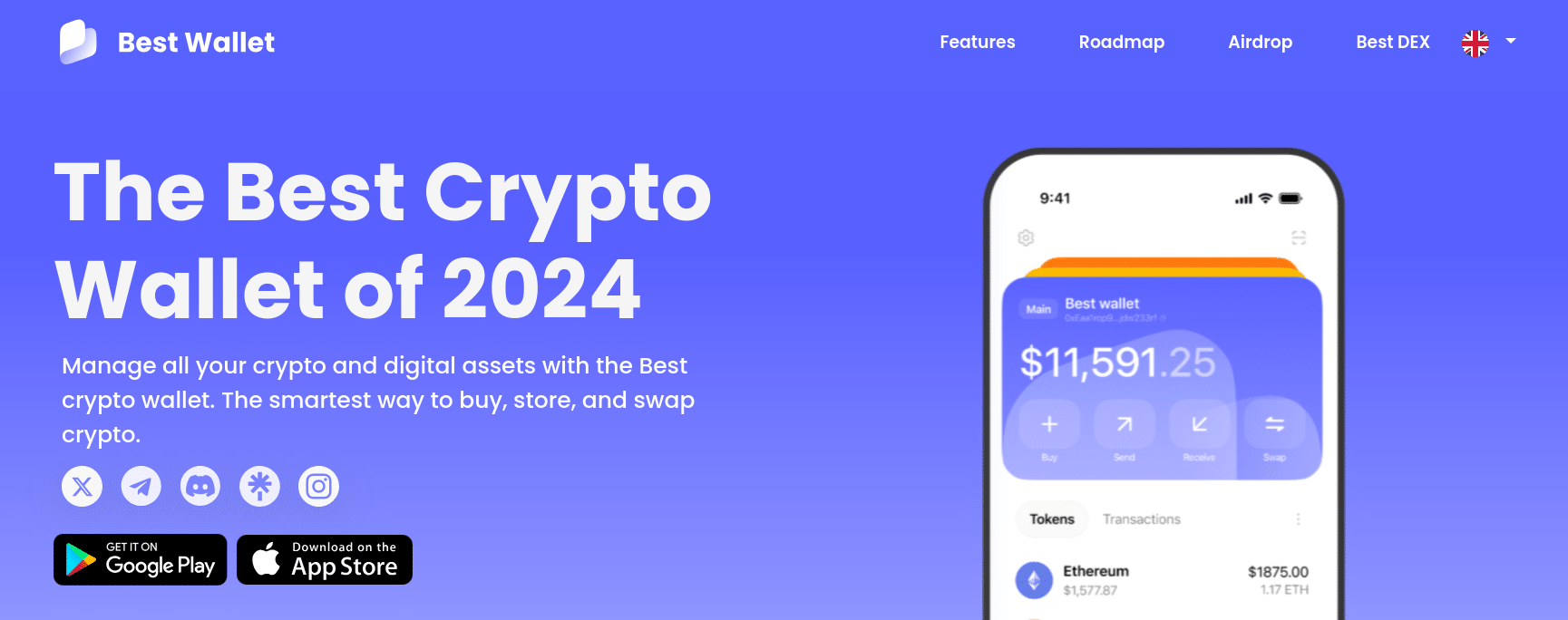
Furthermore, Best Wallet offers multi-chain capabilities, allowing users to access the Ethereum, Polygon, and Binance Smart Chain mainnet. Best Wallet also offers portfolio management tools, allowing users to track real-time profit and losses.
When trading Tether, users can access real-time market updates and analyze the market sentiment of the particular token. For further benefits when trading Tether, Best Wallet users can hold $BEST, its native token.
$BEST token holders do not pay gas fees on trades, and also receive lower-cost trades on the platform’s own decentralized exchange. To protect user’s funds, Best Wallet uses a combination of two-factor authentication and fingerprint algorithms.
Best Wallet can be accessed through the Google Play Store and App Store.
| Tether Wallet | Type of Wallet | Other Supported Networks | Mobile App? | Fee to Buy Tether | Wallet Price |
| Best Wallet | Non-custodial | Ethereum, Polygon, BSC | Yes | Determined by third-party | Free |
Pros
- Multi-chain wallet
- Gives users control of their private keys
- Offers portfolio management tools
- Discounts with the $BEST token
- Access to market insight
Cons
- Not compatible with the Bitcoin network
- Only accessible through mobile devices
2. Exodus – Multi-Chain Web 3 Wallet Supporting Over 50 Network Standards
 Exodus is a decentralized Tether wallet that supports multiple device types. Desktop users can download native software to a Mac, Linux, or Windows device. Alternatively, Exodus also offers a browser extension for increased convenience. There’s also a mobile app for Android and iOS. In addition to Tether, Exodus supports more than 50 other network standards.
Exodus is a decentralized Tether wallet that supports multiple device types. Desktop users can download native software to a Mac, Linux, or Windows device. Alternatively, Exodus also offers a browser extension for increased convenience. There’s also a mobile app for Android and iOS. In addition to Tether, Exodus supports more than 50 other network standards.
This is ideal for storing multiple crypto investments in one safe place. Supported networks include Bitcoin, BNB Chain, Solana, XRP, and more. Exodus – which was founded in 2015, is completely free. There are no fees to receive or store Tether, nor any markups on outgoing transfers. Exodus makes money from third-party services.
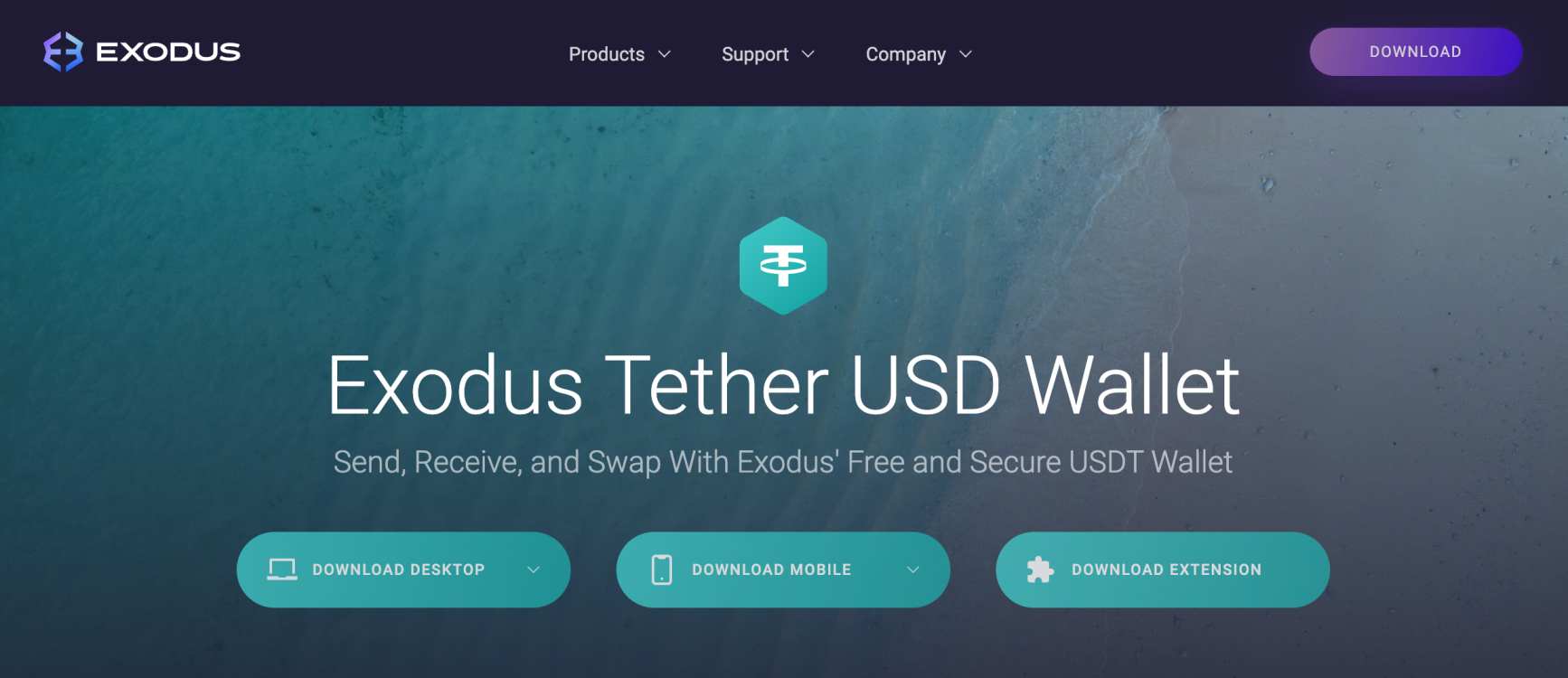
This includes debit/credit card purchases via fiat gateways, staking tools, and token swaps. There is no requirement to use these services, as Exodus connects with Web 3 applications. For instance, suppose you’re using the Exodus app and want to swap Tether for Ethereum. Simply connect to Uniswap to complete the exchange without paying additional fees.
| Tether Wallet | Type of Wallet | Other Supported Networks | Mobile App? | Fee to Buy Tether | Price |
| Exodus | Software (Hot) | Bitcoin, BNB Chain, Solana, XRP, Dogecoin, Polygon, TRON, and more | Yes | Determined by the partnered fiat gateway (with a markup) | Free |
Pros
- Store thousands of tokens from 50+ network standards
- Instantly connects with Web 3 applications
- QR scanning tool for seamless Tether transfers
- Comes as an app, desktop software, or browser extension
- No fees to store or receive Tether
Cons
- High fees on additional services, such as fiat gateways
- Difficult to get past the bot when using live chat
3. Zengo – Self-Custody Wallet App for iOS and Android Without a Single Point of Failure
 Zengo is one of the safest Tether wallets for mobile users. It’s a self-custody wallet, so you’re responsible for keeping it secure. However, unlike other wallets, Zengo doesn’t have a single point of failure. This is because it doesn’t use traditional private keys. Instead, the credentials are split in two. The first segment is stored on the user’s mobile device.
Zengo is one of the safest Tether wallets for mobile users. It’s a self-custody wallet, so you’re responsible for keeping it secure. However, unlike other wallets, Zengo doesn’t have a single point of failure. This is because it doesn’t use traditional private keys. Instead, the credentials are split in two. The first segment is stored on the user’s mobile device.
The other segment is stored on Zengo’s servers. So, if either of these locations were hacked, the wallet would remain safe. After all, the hacker would only have half of the wallet’s credentials. In addition, Zengo leverages multi-factor authentication, including cloud storage, biometrics, and email. This helps users recover their wallets remotely.
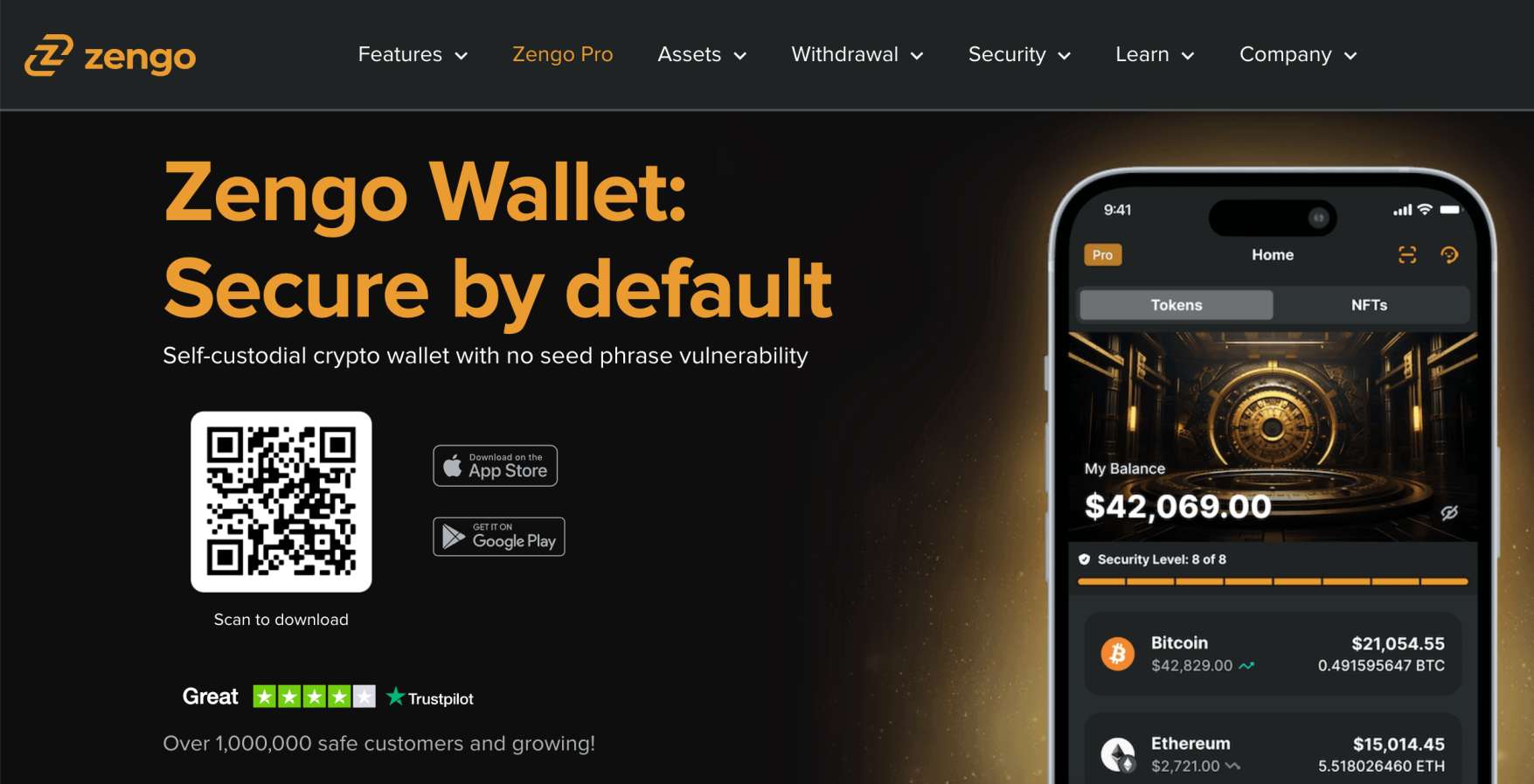
Although Zengo is free, it also offers a Pro plan starting from $9.99 per month. This plan comes with additional security features, although the basic plan is suitable for most users. Zengo’s main drawback is that it lacks support for several popular networks, including Solana, Arbitrum, and XRP. It does, however, support Bitcoin, Ethereum, BNB Chain, and Dogecoin.
| Tether Wallet | Type of Wallet | Other Supported Networks | Mobile App? | Fee to Buy Tether | Wallet Price |
| Zengo | Software (Hot) | Bitcoin, BNB Chain, and Dogecoin, plus respective network tokens | Yes | Varies depending on the fiat gateway, currency, and payment type | Free, but also offers a premium plan at $9.99 per month |
Pros
- Secure Tether wallet without a single point of failure
- 3FA security helps users recover their wallets remotely
- Also supports Bitcoin, BNB Chain, and Dogecoin
- The free plan is sufficient for most users
- Compatible with DeFi ecosystems via WalletConnect
Cons
- Doesn’t support the Solana network
- Live chat replies can take up to 24 hours
4. ELLIPAL Titan 2.0 – Top Wallet Uses Air-Gapped Technology
 ELLIPAL Titan 2.0 comes as a small hardware device and it’s packed with safety features. Like other hardware wallets, ELLIPAL Titan 2.0 is never connected to the internet. While this means the wallet can’t be hacked remotely – ELLIPAL Titan 2.0 takes security to the next level.
ELLIPAL Titan 2.0 comes as a small hardware device and it’s packed with safety features. Like other hardware wallets, ELLIPAL Titan 2.0 is never connected to the internet. While this means the wallet can’t be hacked remotely – ELLIPAL Titan 2.0 takes security to the next level.
This is because the wallet comes with air-gapped technology. In a nutshell, this removes all external connections from the device, including WiFi, Bluetooth, networks, and USB. Transactions are confirmed by scanning a unique QR code from the ELLIPAL mobile app. The QR code is displayed on the hardware device.

ELLIPAL Titan 2.0 isn’t just the safest wallet for Tether, but it also supports other ERC-20 tokens, such as Dai, FLOKI, and Chainlink. Other network standards include Solana, Bitcoin, Binance Chain, XRP, Cardano, and Dogecoin. ELLIPAL Titan 2.0 is sold on the official website for $169. This is worth paying to protect your crypto investments.
| Tether Wallet | Type of Wallet | Other Supported Networks | Mobile App? | Fee to Buy Tether | Wallet Price |
| ELLIPAL Titan 2.0 | Hardware (Cold) | Bitcoin, Solana, Cardano, XRP, BNB Chain, and more | Yes | Determined by the partnered fiat gateway | $169 |
Pros
- Uses air-gapped security
- Removes all external threats – including WiFi, Bluetooth, and USB
- Also supports Bitcoin, Solana, Cardano, XRP, and other blockchain standards
- Comes as a small device that’s easily transportable
- Customer support is highly rated
Cons
- $169 price tag will be too high for some users
- While staking tools are offered, Tether isn’t supported
5. Ledger Nano X – Security-First Tether Wallet With Token Swaps, Web 3 Integration, and Fiat Gateways
 Ledger Nano X is one of the best decentralized crypto wallets for storing Tether. It offers the ideal balance between convenience and security. Ledger Nano X is a hardware wallet but it offers a full suite of additional features. This includes a fiat gateway, allowing users to buy cryptocurrencies with debit/credit cards, bank transfers, and e-wallets.
Ledger Nano X is one of the best decentralized crypto wallets for storing Tether. It offers the ideal balance between convenience and security. Ledger Nano X is a hardware wallet but it offers a full suite of additional features. This includes a fiat gateway, allowing users to buy cryptocurrencies with debit/credit cards, bank transfers, and e-wallets.
Ledger Nano X also offers seamless token swaps. This means you can exchange Tether for other cryptocurrencies without leaving the Ledger ecosystem. What’s more, Ledger Nano X connects with Web 3 platforms, such as Uniswap, SushiSwap, and OpenSea. These features are accessible via the Ledger Live software, which supports mobile and desktop devices.
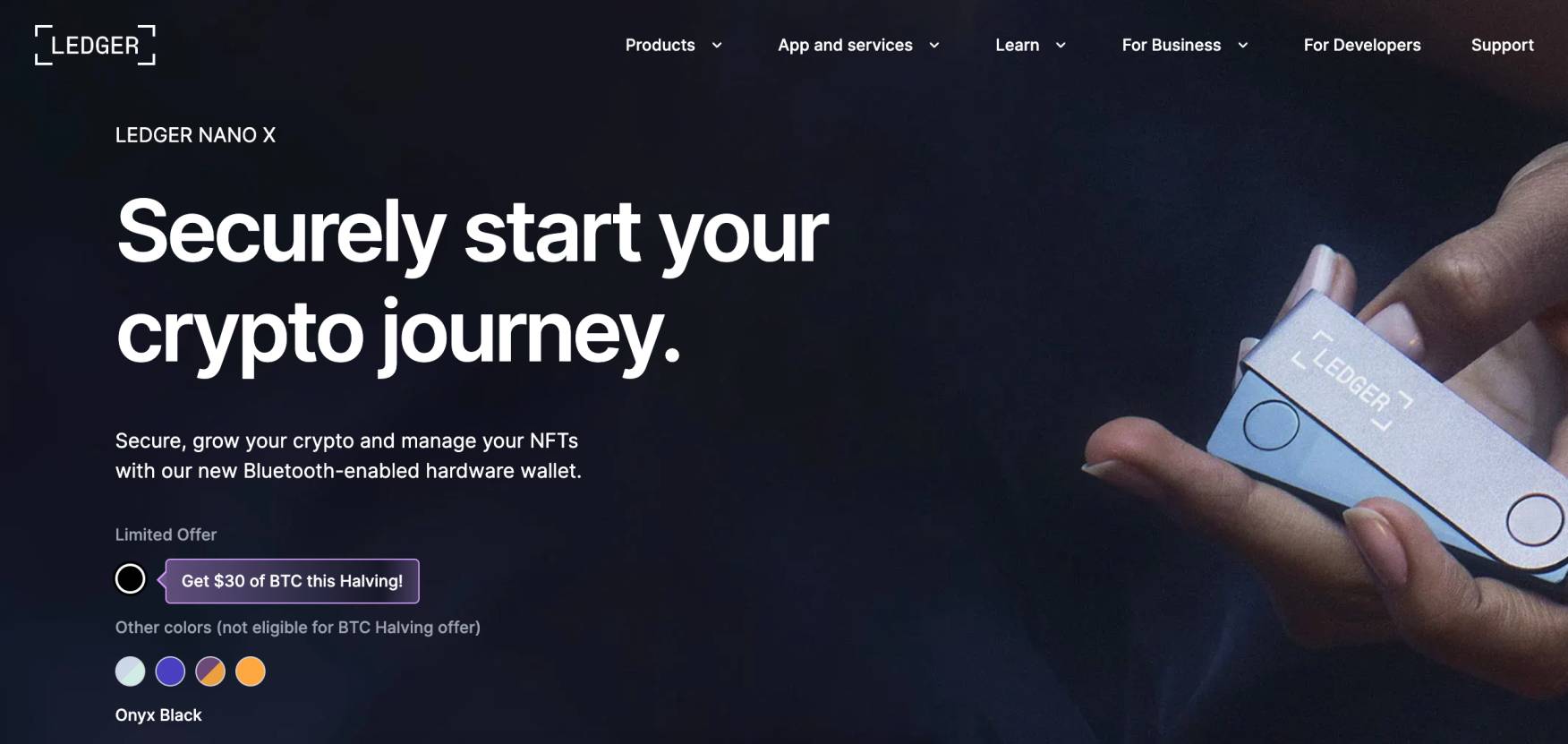
Compatible operating systems include iOS, Android, Windows, Mac, and Linux. In terms of security, Ledger Nano X comes with cold storage, tamper-free devices, and a 4-8 digit PIN for confirming transactions. A backup passphrase is also provided when setting up the wallet. Ledger Nano X retails for $149. Ensure devices are purchased directly from the Ledger website.
| Tether Wallet | Type of Wallet | Other Supported Networks | Mobile App? | Fee to Buy Tether | Wallet Price |
| Ledger Nano X | Hardware (Cold) | Bitcoin, BNB Chain, Solana, XRP, Cardano, Dogecoin, and more | Yes | Determined by Changelly in real-time | $149 |
Pros
- Established hardware wallet provider with multi-network support
- Outgoing transfers require a physical PIN
- Easily buy, sell, and trade tokens without leaving the wallet
- No markup on network fees
- Can be recovered remotely via a backup passphrase
Cons
- At $149, not the most affordable Tether wallet
- Third-party fiat gateway fees are often high
6. OKX Wallet – Access Decentralized Markets, Liquidity Pools, and High APYs on Tether Deposits
 The next option to consider is OKX Wallet. This is a top-rated decentralized wallet that supports Web 3 products. It’s compatible with multiple device types, including mobiles, desktops, and browser extensions. Tier-one security features are available, including MPC (multi-party computation) technology.
The next option to consider is OKX Wallet. This is a top-rated decentralized wallet that supports Web 3 products. It’s compatible with multiple device types, including mobiles, desktops, and browser extensions. Tier-one security features are available, including MPC (multi-party computation) technology.
This distributes the private keys across multiple locations, removing a single point of failure. In terms of Web 3 products, OKX Wallet is one of the best options for earning Tether yields. It connects with hundreds of liquidity pools to secure the highest APYs. This includes Yearn.finance, Compound, Aave, and Flux Finance.

For instance, users can currently earn Tether APYs of up to 7.52%. According to our OKX Wallet review, it is also ideal for swapping tokens. It supports dozens of blockchain standards from the leading decentralized exchanges, such as SushiSwap, PancakeSwap, and Maverick. Additional networks include Solana, BNB Chain, Base, Optimism, and Sui.
| Tether Wallet | Type of Wallet | Other Supported Networks | Mobile App? | Fee to Buy Tether | Price |
| OKX Wallet | Software (Hot) | Bitcoin, Solana, BNB Chain, Base, Kava, Avalanche, Litecoin, and more | Yes | Determined by liquidity providers | Free |
Pros
- Decentralized wallet with MPC security
- Supports browsers, desktops, and mobiles
- Aggregates Tether APYs from the leading liquidity pools
- Also offers cross-chain token swaps
- Compatible with over 70 blockchain standards
Cons
- The browser extension doesn’t support Firefox
- Fiat services are only available on OKX’s centralized exchange
7. Trezor Safe 3 – Cost-Effect and Safe Hardware Wallet Supporting Dozens of Blockchain Standards
Trezor Safe 3 is also one of the best Tether wallets for security. It offers a more affordable price tag than other options; the Trezor Safe 3 costs just $79. It stores private keys within the device and transactions are only approved after entering a PIN. What’s more, the Trezor Safe 3 is never connected to the internet. However, it doesn’t offer air-gapped security, which is a drawback.
is also one of the best Tether wallets for security. It offers a more affordable price tag than other options; the Trezor Safe 3 costs just $79. It stores private keys within the device and transactions are only approved after entering a PIN. What’s more, the Trezor Safe 3 is never connected to the internet. However, it doesn’t offer air-gapped security, which is a drawback.
Instead, the wallet requires a USB connection when connecting to the app. Trezor Safe 3 also offers desktop software for Mac and Windows for increased convenience. Both the desktop software and mobile app support additional features, such as debit/credit card purchases, token swaps, and staking.
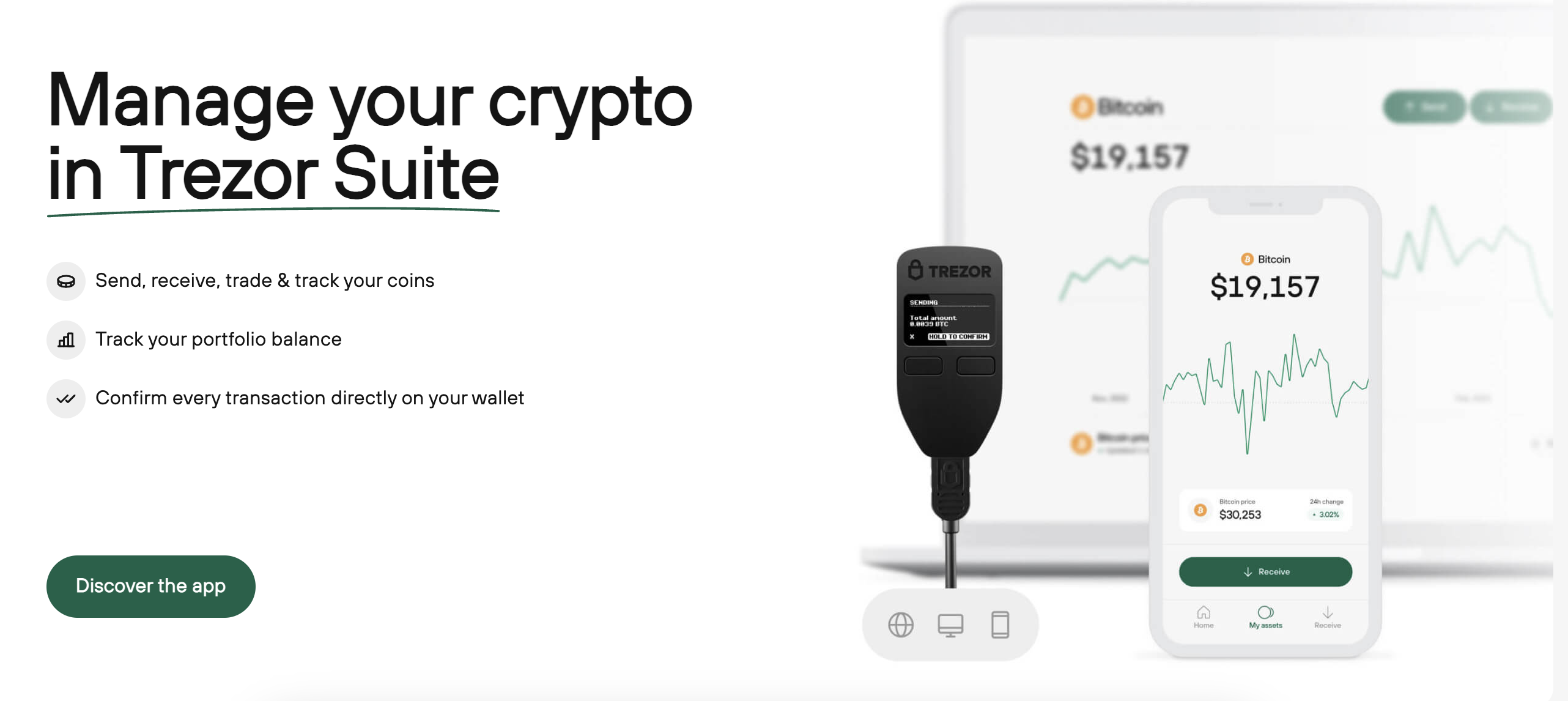
In addition to Tether, Trezor Safe 3 supports all other ERC-20 tokens. It’s also compatible with other popular blockchains, including Bitcoin, BNB Chain, Solana, and Cardano. Trezor Safe 3 also connects with software wallets like MetaMask, which is the safest way to access DeFi platforms like decentralized exchanges and NFT marketplaces.
| Tether Wallet | Type of Wallet | Other Supported Networks | Mobile App? | Fee to Buy Tether | Wallet Price |
| Trezor Safe 3 | Hardware (Cold) | Bitcoin, Solana, Monero, BNB Chain, Dogecoin, Litecoin, Polygon, and more | Yes | Up to 7.49% | $79 |
Pros
- Cost-effective hardware wallet with robust security
- Private keys are never exposed to the internet
- Supports all ERC-20 tokens, including Tether
- Compatible with dozens of other networks
- Comes with a mobile app and desktop software
Cons
- High fees when buying Tether with a debit/credit card
- Doesn’t offer air-gapped security
8. Binance Wallet – Multi-Chain Web3 Wallet Offers High Liquidity
 The next top Tether wallet is offered by Binance. While Binance is a leading cryptocurrency exchange that is used by over 100 million users, it also offers a Web3 wallet which gives access to multiple blockchains and thousands of tokens.
The next top Tether wallet is offered by Binance. While Binance is a leading cryptocurrency exchange that is used by over 100 million users, it also offers a Web3 wallet which gives access to multiple blockchains and thousands of tokens.
Existing exchange users can instantly transfer tokens between the two platforms through the Binance Web3 wallet app. The wallet is powered by Binance Bridge, a tool for facilitating cross-chain token swaps across different networks.
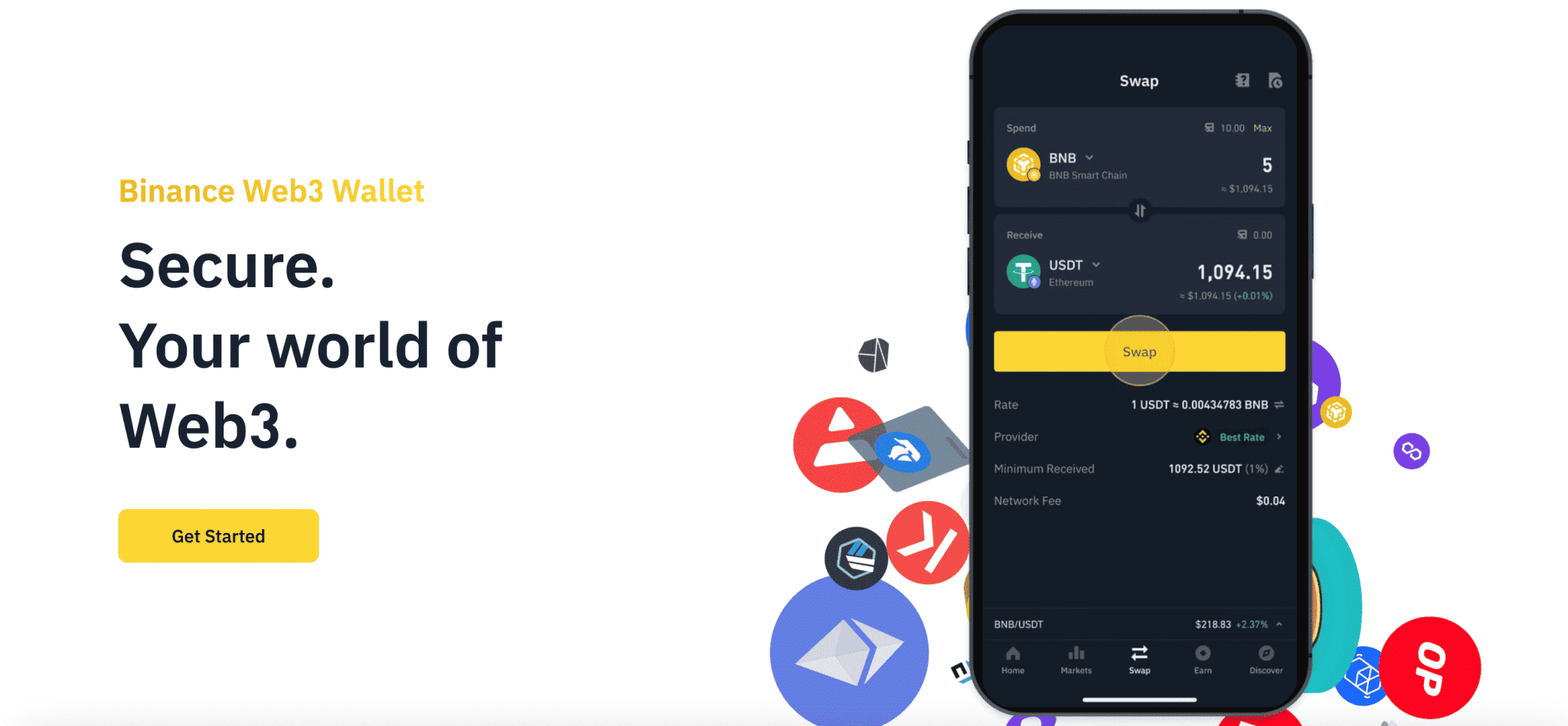
Therefore, users can seamlessly bridge Tether and other tokens seamlessly with Binance. Traders can access some of the best prices on Binance, as it provides high liquidity and low slippage costs.
This wallet is powered by MPC (Multi-party computation) technology, which creates three separately stored key shares. Thus, it provides unparalleled security without the need for a seed phrase.
The app possesses built-in risk controls, providing alerts if a blockchain or token carries any security risk. For all these reasons, Binance’s self-custody wallet is one of the best for storing Tether.
| Tether Wallet | Type of Wallet | Other Supported Networks | Mobile App? | Fee to Buy Tether | Wallet Price |
| Binance Wallet | Non-custodial | BSC, Ethereum | Yes | 0.1% per transaction + third-party fees | Free |
Pros
- High liquidity
- Low slippage costs
- Multi-chain compatibility
- Powered using MPC technology
- In-built risk controls
Cons
- High debit/credit card fees
- May not be ideal for beginners
9. Bybit Wallet – Top Crypto Wallet is Accessible with 20+ Chains
Bybit Wallet  is a top cryptocurrency wallet that allows users to buy, sell, and trade over 10K tokens. Notably, Bybit gives users access to custodial and non-custodial wallets, depending on their preference.
is a top cryptocurrency wallet that allows users to buy, sell, and trade over 10K tokens. Notably, Bybit gives users access to custodial and non-custodial wallets, depending on their preference.
The Bybit cloud wallet is a custodial wallet integrated with a user’s Bybit account. In this wallet, the platform controls a user’s keys. However, Bybit also offers a keyless wallet, which is non-custodial and utilizes MPC technology to secure private keys.

On Bybit, users can trade over 10K tokens, including Tether, across 20 chains. Therefore, tokens can be swapped and bridged seamlessly with the Bybit wallet. On the wallet, users can also invest in new tokens through the Bybit IDO.
Furthermore, Bybit supports staking options to allow users to generate passive income on their investments. Users are required to pay a fee of 0.1% per transaction when trading Tether on the wallet.
| Tether Wallet | Type of Wallet | Other Supported Networks | Mobile App? | Fee to Buy Tether | Wallet Price |
| Bybit Wallet | Custodial/non-custodial | Ethereum, BSC, and 20+ chains | Yes | 0.10% + third-party charges | Free |
Pros
- Custodial and non-custodial wallet options
- Low transaction fees
- Bridges with 20+ chains
- Uses MPC technology to protect private keys
- Access to over 10K tokens
Cons
- Lacks complex security features
- No market insights
10. Keystone – Impenetrable Cold Wallet Offers Top Security Features
 The next Tether wallet on our list is Keystone – a secure cold wallet that is used to initiate effortless transactions.
The next Tether wallet on our list is Keystone – a secure cold wallet that is used to initiate effortless transactions.
Keystone is compatible with some of the top cryptocurrency wallets, including MetaMask, Eternl, and OKX Wallet. The physical wallet boasts a user-friendly touchscreen, which comes with a 4-inch color display and intuitive touch controls.
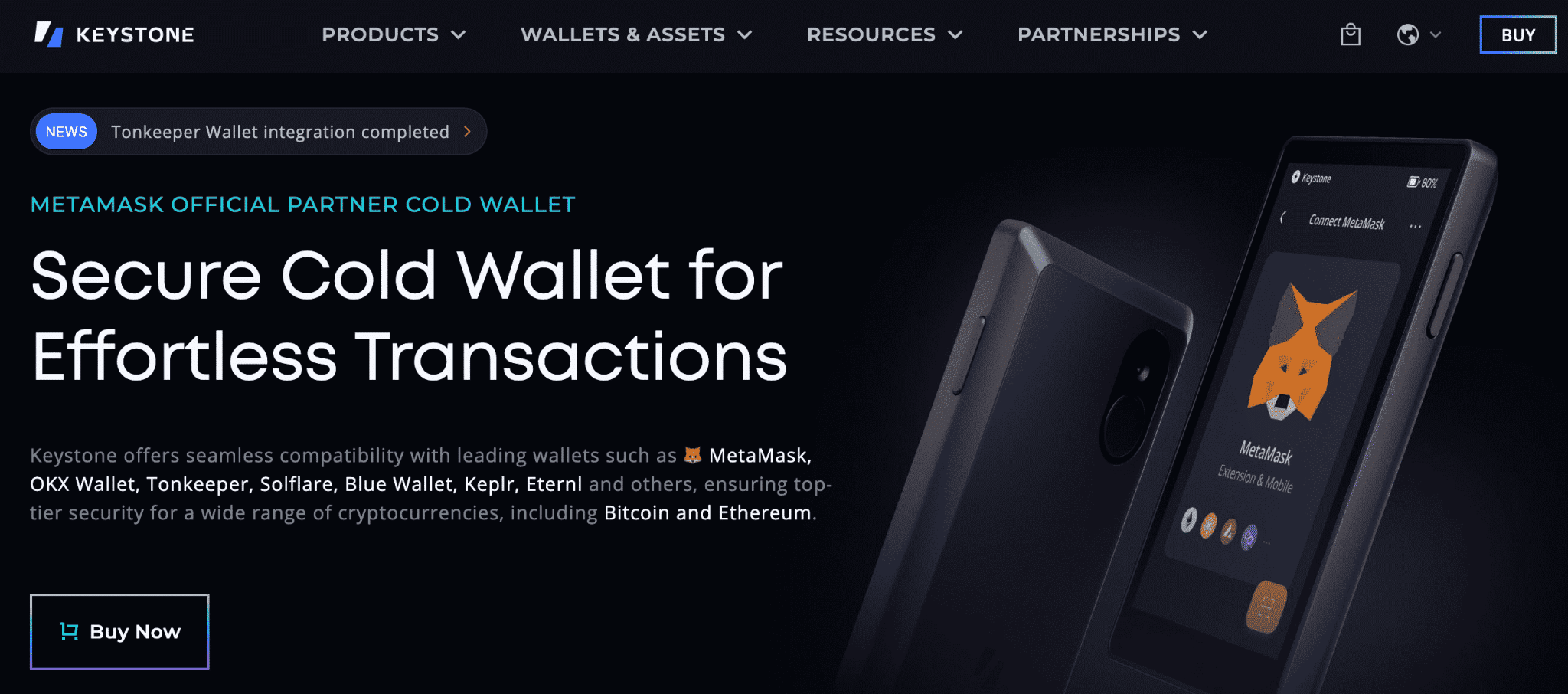
The Keystone wallet is packed with three security chips, offering the highest level of security to customers. Keystone supports private key derivation – a method to derive secret keys by inputting a password or passphrase into the wallet.
This top Tether wallet is also equipped with a PCI anti-tamper feature, which instantly obliterates the wallet’s data upon detecting any physical tracking. Thus, Keystone is an impenetrable cold wallet that allows users to safely store their Tether tokens.
Keystone 3 Pro, the flagship wallet of Keystone, is priced at just $149. The wallet has an open-source code, which can be reviewed and verified by anyone.
| Tether Wallet | Type of Wallet | Other Supported Networks | Mobile App? | Fee to Buy Tether | Wallet Price |
| Keystone | Hardware (Cold) | Bitcoin, Ethereum, Polygon, and more | No | Determined by the partnered fiat gateway | $149 |
Pros
- Intuitive user interface
- Compatible with multiple wallets
- Three security chips
- PCI anti-tamper features
- Open-source wallet
Cons
- Hefty price of $149
- No staking features
Why Do You Need a Tether Wallet?
Tether (USDT) is a digital asset stablecoin that must be stored in a wallet. Otherwise, you’ll need to keep your USDT tokens in a centralized exchange, meaning you hand over control. This is because the exchange controls the wallet’s private keys, so you can’t withdraw the USDT tokens without receiving approval.
In contrast, the best wallets for Tether offer a decentralized framework. Only the user has access to the private keys, so USDT can be sent and received freely. Moreover, nobody has access to the USDT tokens, so it’s like keeping cash in a private safe rather than a bank account. Put otherwise, decentralized Tether wallets can’t be frozen or seized.
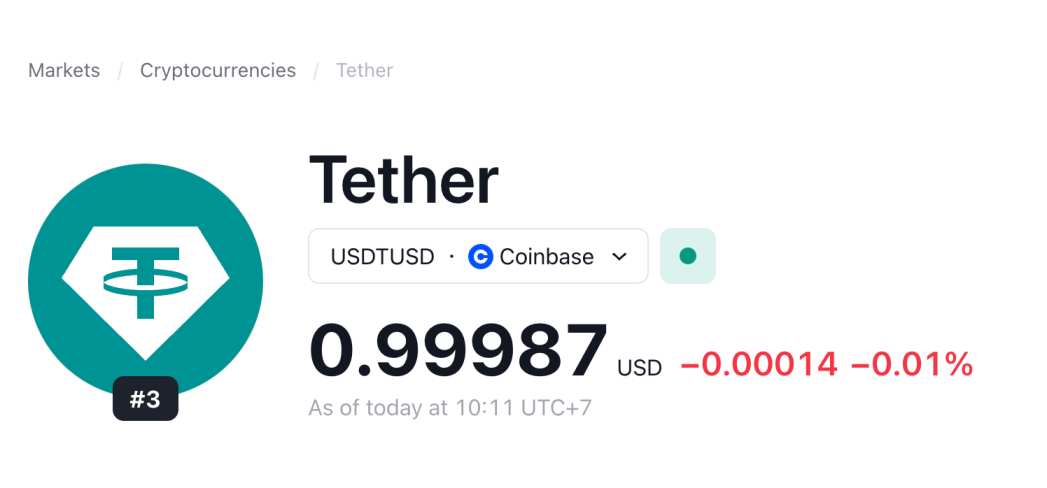
Tether wallets are also ideal for accessing the broader crypto markets. For instance, you can connect most wallets to decentralized exchanges like Uniswap and SushiSwap. This means you can use the USDT balance to purchase other cryptocurrencies, such as Ethereum, Dai, Axie Infinity, or Shiba Inu.
Some Tether wallets also facilitate earning tools. For example, you can connect the wallet to a DeFi platform and generate competitive yields. Ultimately, most people hold USDT for liquidity purposes, allowing them to buy cryptocurrencies when a new market opportunity arrives. As such, it’s crucial to choose a safe Tether wallet.
Different Types of USDT Wallets
Tether wallets come in many shapes and sizes. You’ll come across various terms – some are used interchangeably. For example, ‘non-custodial’, ‘self-custody’, and ‘decentralized’ wallets all refer to the same thing; only the user has control of the private keys. While ‘custodial’ crypto wallets are offered by centralized providers, meaning the private keys are not shared with users.
You’ll also encounter the terms ‘hot’ and ‘cold’ wallet. Hot wallets are software-based and always connected to the internet. Cold wallets always remain offline; they usually come as a hardware device and store private keys offline. And don’t forget about paper wallets—a free way to store USDT tokens offline.
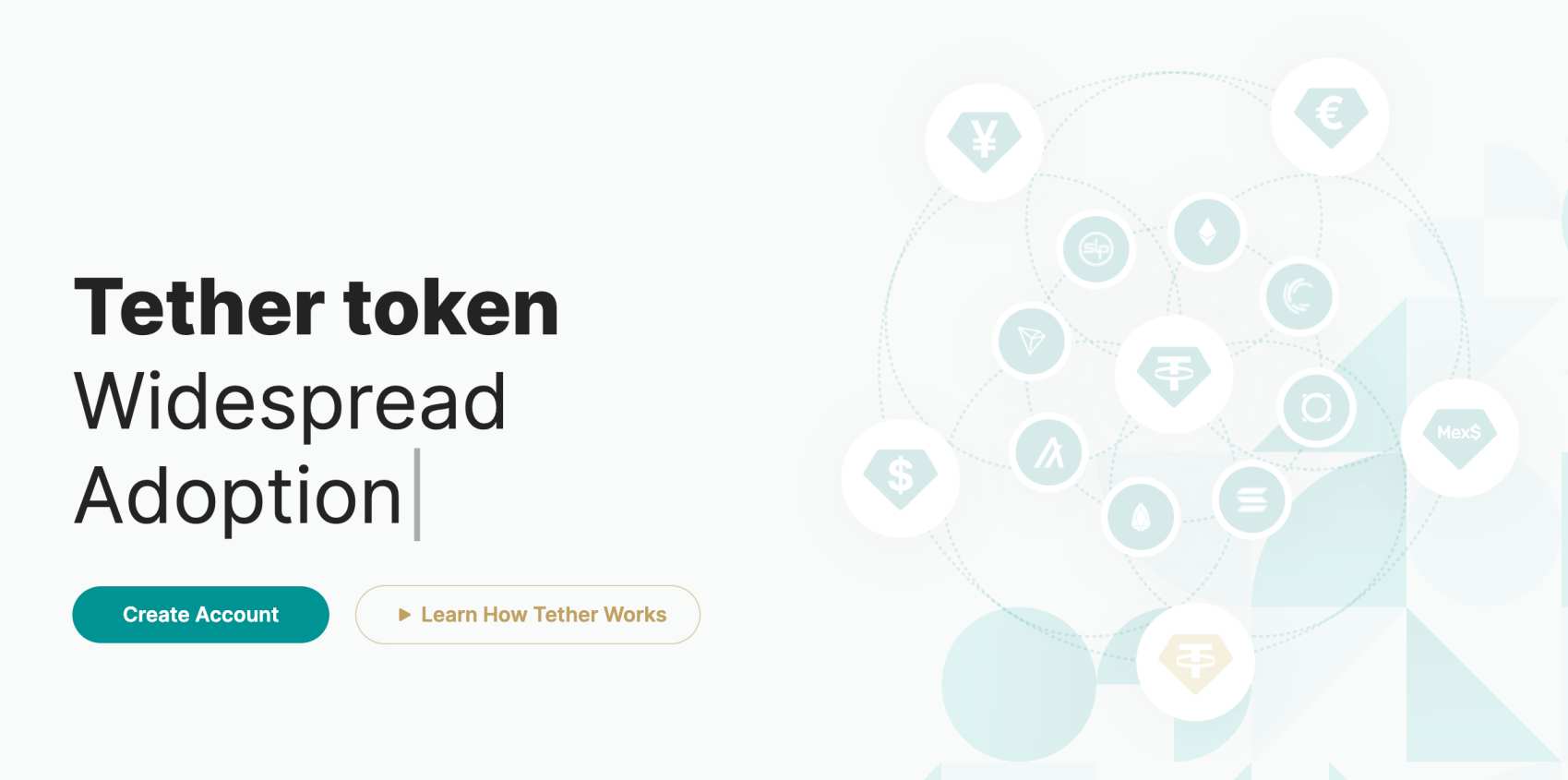
Naturally, differentiating between the different wallet types can be confusing. Let’s take a closer look at how each option works so you can choose the best Tether wallet for you.
Custodianship
The first step is to determine whether you want a custodial or non-custodial wallet
Apart from a few, the Tether wallets list on this page are all non-custodial. This is because non-custodial wallets remove counterparty risks; only you have access to the private keys.
This means you can store, send, and receive tokens without relying on a third party. You can also remain on-chain, meaning you can swap USDT for other tokens without centralized exchanges. However, the drawback is you’re responsible for security. If the private keys are hacked or you lose the backup passphrase – your Tether will be recoverable.
- All that said, complete beginners without any crypto knowledge might prefer a custodial wallet.
- Security and safety is the custodian’s responsibility.
- This means you can leave the USDT tokens in an exchange account. Access to the funds simply requires login credentials.
However, as seen with the FTX bankruptcy in 2022, you never truly own your USDT tokens when using a centralized platform. After all, the custodian could use your USDT tokens to fund its operations, make risky loans, cover losses, or make fraudulent activities. Therefore, it’s worth learning about wallet security so you can become your own USDT custodian.
Tether Software Wallets
We’ve established that software wallets are always connected to the internet, so they’re ideal for regularly engaging with the blockchain ecosystem. For instance, swapping USDT tokens or earning yields.
Within the software wallet category, there are several options available:
- Mobile Wallet: A popular option with many investors is a mobile wallet. Simply download the app to a smartphone, create a new wallet, and fund it with USDT tokens. Access typically requires a PIN or fingerprint ID.
- Desktop Wallet: A less common option is a desktop wallet, often available as Windows or Mac software. They’re less convenient than mobile wallets, as you can’t transact without the device.
- Browser Wallet: Some Tether wallets come as a browser extension. Chrome, Firefox, and other popular browsers are often supported. Browser wallets are protected by a password.
- Web Wallet: This wallet type is offered by centralized exchanges, meaning you won’t control the private keys. Access is provided by logging into your account. Most web wallets support two-factor authentication.
Overall, I prefer mobile wallets in the software category. They’re a lot more secure than other software wallets, considering transactions can only be made when using the device. What’s more, biometric logins are available. Mobile wallets are also convenient; all you need is a smartphone device with an internet connection.
Tether Hardware Wallets
The second category to consider is a Tether hardware wallet. This is the safest way to store USDT tokens. For a start, hardware wallets offer cold storage, so they’re never exposed to internet risks, such as phishing or malware. Moreover, the private keys are secured within the device.
Some hardware wallets – such as ELLIPAL Titan 2.0, also come with air-gapped security. Not only does this remove internet threats but also other connection risks – such as USB and Bluetooth. There are also Tether hardware wallets that leverage MPC security, such as Zengo and OKX Wallet.

This removes a single point of failure, meaning private key thefts are almost impossible. That said, all hardware wallets have a common denominator; USDT transfers must be authorized from the device. This is usually with a PIN, although ELLIPAL Titan 2.0 uses a QR code system. Either way, wallet movements aren’t possible without the hardware device itself.
The drawback of hardware wallets is they’re not free. You’ll need to purchase a wallet from the manufacturer, plus shipping fees. Prices vary depending on the provider and model. For example, ELLIPAL charges $169 for its Titan 2.0 model. Those looking for a cheaper option might prefer the Trezor Safe 3, which costs just $79.
Tether Paper Wallets
Tether paper wallets sit within their own unique category. They offer a free alternative to cold storage without needing to buy a hardware device. While less convenient than hardware wallets, paper wallets offer unprecedented security. This is because the wallet credentials are written down on a piece of paper, so there’s exposure to networks, Bluetooth, or internet connections.
- To use the paper storage system, you initially require a software wallet.
- This is because you need to create a Tether wallet address and private keys. Exodus can be used.
- Download the respective app and create a new wallet. This is your unique Tether wallet address.
- Next, you’ll need to write down the backup passphrase provided by the software wallet. Ensure this is written down in the correct order. Crucially, the backup passphrase represents your private keys.
- Next, transfer the USDT tokens to the newly created wallet address. Wait a couple of minutes for the tokens to arrive.
Once the tokens arrive, you can then delete the software wallet app from your device. At this stage, the private keys are located in just one place: your paper wallet. This means wallet hacks are impossible.
There is just one risk to consider. If you lose or damage the paper wallet, recovery won’t be an option. This is because the backup passphrase isn’t stored anywhere else. As such, make sure the paper wallet is stored somewhere secure – preferably in a fire-proof safe.
How to Pick a Safe Tether Wallet
The first step is to ensure the chosen wallet is compatible with the Ethereum network. After all, Tether is an ERC-20 token that operates in the Ethereum ecosystem. After that, users should prioritize Tether wallets with the best security features. Options will vary depending on the wallet type.
For example, the most secure option is cold storage, which removes internet risks and hacking threats. Hardware and paper wallets supported this method. However, transacting can be cumbersome, so software wallets might be a better option for active traders. Those opting for a mobile wallet should ensure biometrics are supported.
You can also use the phone’s screen lock feature as an additional safety net. I’d also suggest wallets offering two-factor authentication. This doubles the security strength, as two separate devices are required, such as a laptop and a mobile device. Another feature offered by some Tether wallets is MPC technology, which splits the private key across several locations.
You might also consider Tether wallets offering air-gapped technology, meaning the wallet is never directly connected to another device (e.g. Bluetooth or USB). Ultimately, unless you have an intimate understanding of wallet technology, the safest option is to stick with reputable and established wallet providers with millions of active users.
How I Ranked the Best USDT Wallets
I utilized a checklist methodology when ranking the best USDT wallets, covering various factors. This includes everything from pricing, security features, and supported blockchain standards to reputation, device types, and user-friendliness. Tether wallet providers were given a ranking score for each factor, ensuring that all preferences were catered for.
I’ll now break down my checklist requirements so that you can choose a suitable Tether wallet.
USDT Custody
I mainly focused on self-custody wallets, which ensure holders have full control of their USDT tokens. No authorization is needed when transferring funds, so users can directly engage with the blockchain ecosystem.
That said, I also included a custodial wallet, as some investors – especially beginners, won’t be comfortable securing their private keys.
Device Types
Everyone has their own preferences when it comes to device types. As such, I included the top Tether wallets for mobiles, desktops, browsers, and hardware devices.
I also ensured that the most popular operating systems were included, such as iOS, Android, Windows, Mac, and Chrome. Some Tether wallets offer multi-device support, meaning they appeal to a wider audience.
Pricing
The Tether wallets ranked on this page have prices between $0 and $169. This ensures that all budgets and investment requirements are supported. For example, those holding a small number of USDT tokens might not want to purchase a wallet.
However, the most secure Tether wallets are hardware devices, meaning a purchase is required. This will be the best option for those holding a large amount of USDT alongside other cryptocurrencies.
Compatible Blockchains
At a minimum, Tether wallets are compatible with the Ethereum blockchain. This means that all ERC-20 tokens can be stored. However, investors will often hold cryptocurrencies from other blockchains, such as Solana, BNB Chain, or Bitcoin.
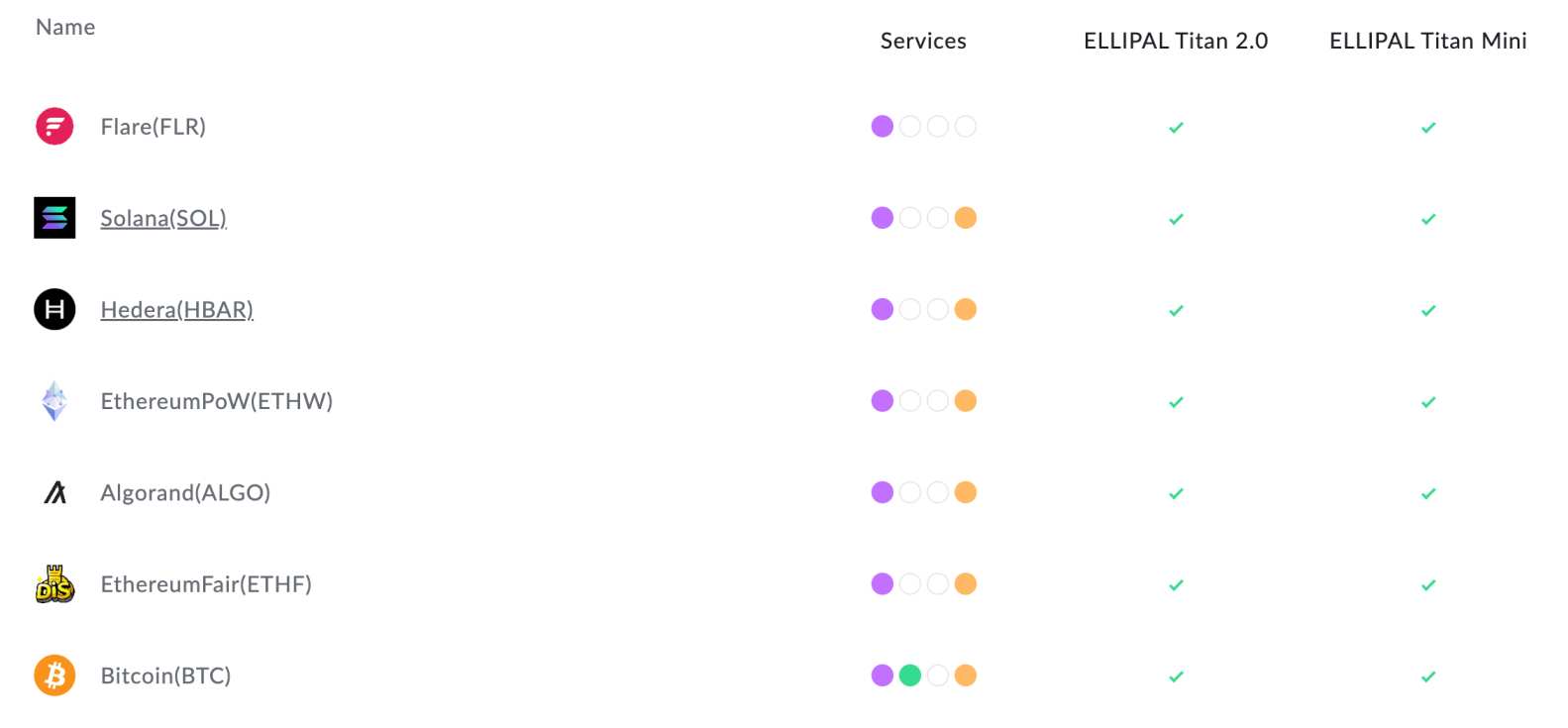
Multi-chain wallets were ranked highly, as diversified portfolios can be held in one location.
Trading Features
USDT isn’t an investment token, as it’s pegged to the US dollar. As such, most people hold USDT as a liquidity token – meaning they easily trade cryptocurrencies without needing to deposit fiat money. With this in mind, I focused on Tether wallets that come with trading features.
For example, the best providers offer in-wallet token swaps. This means you can swap USDT for other ERC-20 tokens without using an exchange. Some Tether wallets come with bridge technology, so USDT can also be swapped with other network standards.
In addition, some wallets have partnered with fiat gateways like MoonPay and Simplex. This enables users to buy (and sometimes sell) USDT with fiat money. Visa, MasterCard, and other convenient payments are typically supported. Keep an eye on fees and spreads, as fiat gateways can be expensive.
Security and Reputation
The Tether wallets on this page are established and reputable. Most have been operating for multiple years and boast millions of active users. I also analyzed security features when ranking providers.
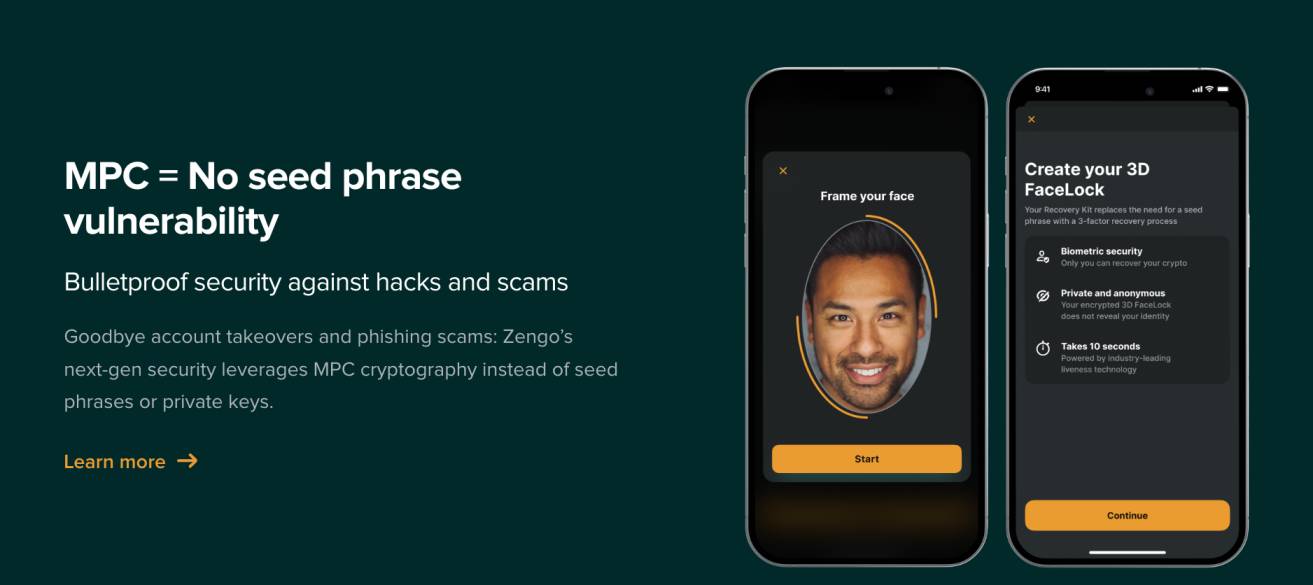
I prioritized wallets with open-sourced code, meaning anyone can view potential vulnerabilities. I also focused on providers offering two-factor authentication and biometrics. Crucially, hardware Tether wallets were ranked the highest, as they offer the most secure storage systems.
How to Get a Tether Wallet
I’ll now explain how to get a Tether wallet in 2024. Follow to steps below to safely store USDT tokens in a software wallet.
Note: If you want a hardware wallet, you’ll need to order one directly from the manufacturer. The setup process will vary depending on the wallet; follow the instructions provided.
- Step 1: Choose a Tether Wallet Type: It’s important to choose the right Tether wallet, as the number of options is vast. In addition to custodianship, consider whether you prefer a mobile, desktop, or browser wallet.
- Step 2: Create a New Wallet: Once you’ve selected a wallet, download it to your preferred device type. Open the wallet and begin the set-up process. This includes creating a new wallet which is unique to your device.
- Step 3: Set up Security Credentials: The next step is to secure your Tether wallet. This means creating a PIN or password. Biometrics are also an option when using a mobile wallet.
- Step 4: Note the Backup Passphrase: The most important step is writing down the wallet’s backup passphrase. This represents your private keys, so never write them on a device (like in an email or on a Google Doc). Instead, it should be written on a sheet of paper and kept somewhere secure.
- Step 5: Transfer USDT Tokens: Your Tether wallet is now set up and secured. You can now add some USDT tokens. You can send the tokens to your unique Ethereum wallet address. This is the same address used for ERC-20 tokens like USDT. Most USDT transfers arrive in under two minutes.
Conclusion
I’ve covered everything you need to know about storing USDT tokens, including an overview of the best Tether wallets for 2024. My overall pick is Best Wallet. This multi-chain cryptocurrency wallet offers detailed market insights, and offers portfolio management tools to easily allow users to maintain their assets.
Best Wallet has also launched its own native token, $BEST, which can be held to earn token airdrops and trading discounts.
FAQs
Where can I store USDT?
You can store USDT in any crypto wallet that’s compatible with the Ethereum blockchain. This is because USDT is an ERC-20 token.
Which wallet is best for Tether?
The best Tether wallet for safety is Best Wallet – a multi-chain non custodial crypto wallet. With Best Wallet, users can access market insights, portfolio management tools, and secure trading discounts.
How do I create a Tether USDT account?
Visit the official Tether website and click ‘Sign Up’. Follow the on-screen instructions to open a USDT account. However, note that USD redemption has a minimum of 100,000 USDT when going directly with Tether, so it’s best to use an exchange.
How do I get my money out of Tether?
If you’ve opened an account directly with Tether and hold USDT in that account, you can convert it back to US dollars. However, this service requires a minimum redemption of 100,000 USDT. Instead, consider transferring the USDT tokens to an exchange and selling them for fiat money.
Can I transfer USDT to my bank account?
No, USDT is a digital currency – it can’t be transferred to a bank account. You can, however, swap USDT for fiat money on a crypto exchange and then withdraw the funds to a bank account.
References
- Secure Multi-Party Computation (Chainlink)
- What are Tether tokens and how do they work? (Tether)
- Embattled Crypto Exchange FTX Files for Bankruptcy (The New York Times)
- Stablecoin Tether gets boost as dollar alternative in emerging markets, CEO says (Reuters)


